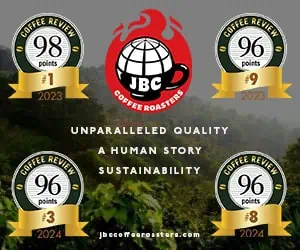The term “decaffeinated espresso” gets even more snickers from coffee insiders than do allusions to ordinary decaffeinated coffee. The assumption seems to be that espresso is such a strong intensification of coffee-ness that drinking a decaffeinated version of it is a particularly perverse contradiction.
In fact, decaffeination and espresso can be surprisingly well suited to one another. The espresso system, with its rapid extraction of strong, concentrated coffee, tends to intensify any extreme characteristic of a green coffee, particularly high acidity. This is why the predominant coffees in most espresso blends tend to be rather low-key: chocolaty, low-acid Brazils, low-acid, malty/musty Sumatras, in Europe robustas with their heavy neutrality.
Consequently decaffeination, which tends to mute the overall characteristics of a green coffee, can actually function as an advantage in espresso blending, rounding the potential sharp edges of a green coffee while leaving behind enough of the individuality the coffee needs to usefully add an enriching voice to a blend.
Eight at 90 or Better
Nevertheless, the overall success of the fourteen decaffeinated espresso blends reviewed here is particularly impressive, despite any hypothetical advantage lent the blender by decaffeination.
The delicacy and variability of decaffeinated coffees always make them a challenge to roast, and the roasting in the twenty decaffeinated blends we tasted for this month’s article (from eighteen different American roasting companies) was, with a single exception, impressively tactful and sensitive. Eight of the twenty coffees we tested attracted ratings of 90 or better.
Stylistic Variety
Furthermore, these blends in their variety seemed to nicely reflect the style and intentions of blender and roastmaster.
The very impressive Natural Decaf Espresso (94) from the large Caribou Coffee chain was fruity, complex and syrupy. The equally successful Decaf Organic Caffe Volcan (94) from the much smaller Los-Angeles-area roaster Supreme Bean displayed unusually vivid floral nuance along with rich semi-sweet chocolate notes. I particularly admired the way both the Caribou and Supreme Bean blends preserved their individuality and nuance despite the diluting, sweetening influence of milk. The Decaf Roastmaster’s Choice Espresso from Fidalgo Bay Coffee (93) foregrounded the blueberry and chocolate nuance typical of lightly fermented dry-processed coffees, producing an espresso with a fruitily exotic character.
The very dark-roasted SWP Decaf Espresso from Portland Roasting (92) gave its best in aroma and particularly in milk, where the mild astringency and lean mouthfeel associated with extreme dark roasting were pleasantly rounded by the impact of the milk. On the other hand, Terroir Coffee’s single-origin Costa Rica La Lapa, Northern Italian Style Roast (92) offered an entirely different set of pleasures: the crisp elegance of a fine Central America coffee sufficiently round and sweet to enjoy as a straight espresso shot or in milk, where it bloomed with dry chocolate and wonderfully persistent floral top notes.
The two 91-rated espressos, Fieldheads Espresso Decaf and Zingerman’s Detroit St. Decaf (a Guatemala single-origin) situated themselves at opposing but complementary poles of expression: The Fieldheads was mildly roasty but quiet, smooth and silkily complete. The Zingerman’s decaf Guatemala, rather than understating its roastiness, proclaimed it with pungent, milk-mastering emphasis.
Decaffeination Methods
Some of these blends consisted of coffees decaffeinated by solvent-free methods, usually the Swiss Water Process, which, in a complex series of steps, removes caffeine using only hot water and charcoal filters. Coffees decaffeinated by solvent-free methods like the Swiss Water Process typically are so identified on package and roaster websites, and I pass this information on in the “Notes” sections of this month’s reviews. When no method is mentioned on package or website (as with many of the coffees reviewed here) the decaffeination usually has been carried out with the use of an FDA-approved solvent (typically methylene chloride) that selectively unites with the caffeine and subsequently is steamed out of the beans. Given the steaming process, the volatility of the solvent and the high temperatures applied to the beans during roasting, it is unlikely that much if any solvent residue makes it into the cup. However, if you are troubled by even the hypothetical idea of a solvent, any solvent, in your coffee, then aim your cursor and your dollars at coffees decaffeinated by the Swiss-Water Process or one of the other solvent-free methods that are beginning to surface in the specialty coffee world.
Respect Your Decaf
For me the sensory variety of these decaffeinated espresso coffees speaks to the heart of what specialty coffee should be: various in its expression, quietly individualistic, pushing the expressive possibilities of a demanding coffee form that, even without the caffeine, is worthy of respect and connoisseurship.
Last Notes for Aficionados and Espresso Obsessives
Some observations for those who focus on the absorbing and challenging details of espresso brewing. Nothing new here, I am sure, but notes worth recording given these were all decaffeinated espressos.
The main downside of decaffeination applied to espresso appears to be a more limited production of crema rather than a crippling of flavor and mouthfeel. None of the blends we tested produced the big golden pour of crema aficionados associate with the finest espresso: Crema tended to be persistent and fine-textured, but certainly not big with a melting churn. On the other hand, the somewhat stingier, tighter crema did not appear linked to loss of aromatic power and complexity or more surprisingly, to clear loss of viscosity.
For this series of tests I took notes on all shots I pulled while calibrating the grinder, including those that fell somewhat outside the usual target range of about 20 seconds after the first drop (25 after the press of the button on my La Marzocco) to 30 seconds (35 after the press of the button).
I have two observations to share from this exercise. No surprise that the best results came from shots toward the long, slow end of the range: usually about 30 seconds after the first drop. In some cases, the best shot came in at as much as 35 seconds after the first drop (the Caribou, for example). On the other hand, at least one of the espressos showed best (even in milk) at a much faster 20-second shot. Finally, at a really slow extraction (40 seconds after the first drop, for example) the sweetness and aromatics almost always were compromised by an astringent heaviness. All of this is similar to my experience with non-decaffeinated espressos.
Lastly, it was quite clear that these blends maintained their essential character throughout the acceptable range of extraction time. In other words, full-bodied, syrupy espressos remained full-bodied and syrupy even at relatively fast shots, and rough-finishing espressos stayed rough no matter how slow or fast the shot. Nevertheless, these characteristics tended to show best and most pleasurably, with maximum aromatics and optimum mouthfeel, at certain points in the range, usually around 25 to 30 seconds after the first drop.











